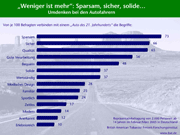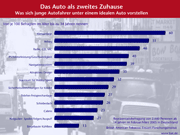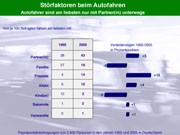Mobility as a quality of life
Mobility as a quality of life
Less is more: economical, safe, solid...
Rethinking among car drivers
In the 1990s, the car was a status symbol of prosperity in Germany: an adventure vehicle, a comfortable all-purpose toy for adults that fulfilled almost all individual desires. The value of the car sometimes even "bought" personality traits. Now drivers are rethinking their behaviour: You have to be able to afford comfort, luxury and a personal touch. A car can be inexpensive again. In difficult economic times, the car is changing from an adventure vehicle to an economy vehicle. When it comes to the "car of the 21st century", almost three quarters of the population (73%) think of the characteristic "economical", whereas only 10 per cent think of the characteristic "eventful". Even young drivers up to the age of 34 rate the fuel economy of a car many times higher (69%) than prestige features such as "fashionable" (41%), "sporty" (40%) or "recognised" (16%). This is the result of a recent representative survey conducted by the B.A.T Freizeit-Forschungsinstitut, in which 2,000 people in Germany were asked about their mobility habits and their ideas about the car of the future.
"The car of the 21st century must first and foremost be economical, safe and solid. However, drivers are not prepared to compromise on safety when it comes to price," says Prof Dr Horst W. Opaschowski, Director of the Institute. "Safety first - at a good price: that is what characterises a quality car at the beginning of the 21st century. The price-performance ratio must be right without losing the desire to drive." The B.A.T study proves this: A modern car must be both powerful and affordable.
The car as a second home.
What young drivers imagine an ideal car to be
The car is heading for a new future. It is becoming a second home. Young drivers in particular want a multi-purpose car and multi-mobile for the future that is just as much fun in traffic jams and stationary traffic as it is when travelling. More than half dream of air conditioning (60%). One in two would like an airbag (51%). Safety should not be spared. And almost half do not want to do without in-car entertainment via radio and CD (46%). A good third (39%) of young drivers expect a modern multi-option car to have a navigation system. An attractive design also plays an important role for new drivers over the age of 18 (35%). And storage space for hobbies and sports is of course a must (32%).
In order not to miss the latest news and not to lose contact with friends, they don't want to do without a hands-free telephone system (27%). Some also dream of an inbuilt cool box (13%), while others are enthusiastic about "eye-catchers" such as spoilers, wheel rims and exhaust pipes (21%). Professor Opaschowski: "Young drivers want to 'furnish' their cars almost as if they were at home. Nevertheless, the playful additional wishes for accessories are kept within narrow limits. Quality, safety and functionality are more important to young people. Rather, there are signs of a shift from performance-orientated to pleasure-orientated driving among young drivers. Driving at top speeds is becoming obsolete. This is more likely to lead to a change from the speed car to the homemobile: comfortable and cosy in comfort - when standing and driving."
Because drivers are inevitably spending more time in their cars than before, they are also learning to appreciate the interior comfort of the car. A vehicle with a touch of cosiness and furnishings. Chilled drinks can be easily served while the air conditioning is in operation and the navigation system makes it easier to avoid traffic jams. Added to this is the car sound of CD music. All the senses travel with you.
Children as disruptive factors?
Drivers prefer to be on the road with their partner only
On longer car journeys, German drivers do not want to have to take anyone into consideration. For them, the most likely options are their partner (43%) or family (19%). And for most drivers, the thought of travelling longer with just a child or children is almost nightmarish. Only 3 per cent of Germans would prefer to have children with them on such trips - far fewer than ten years ago (1995: 12%). Child-friendliness has become much less favourable. Children as disruptive factors? A problematic development.
Professor Opaschowski: "The 'Auto'mobil' is aptly named: it almost drives itself - and is really only there for the driver. Passengers are tolerated, fellow travellers are more of a nuisance. At first glance, the car looks like an egomobile." The discovery of the car as a sociable vehicle for children, family and friends is obviously still pending.
Life between desire and escape.
Why people are mobile en masse
Gaining time and space are more of a pretext for mobility. Rather, it can be assumed that time has become so subjectively valuable today that it simply has to be "utilised" - in order to experience as much as possible and not miss anything.
"Out" and "away" is the goal. Being on the road is often more important than arriving: Getting away from everything that has to do with everyday life. Professor Opaschowski: "People are torn between escaping everyday life and enjoying life, seeking contact and the need for fresh air. Mobility symbolises both: escape and movement." At the top of the list is the desire for a "change of scenery" (40%), the need for variety (39%) and the fear of boredom within one's own four walls, the fear that "the ceiling will fall on one's head" (32%). Just as strong, however, are the urge for adventure (40%) and the desire for adventure (40%), with curiosity (36%) also playing a role.
The survey results lead to the conclusion that the need for mobility often masks a physical urge for movement and activity that could just as easily be satisfied outdoors doing sport, hiking or going for a walk. Provided that the feeling of space is guaranteed so that it conveys a sense of freedom - e.g. when walking in a spacious city park with a wide view, playing golf or sailing on a large lake or sea. Where this is not possible in the immediate vicinity, motorised mobility almost becomes a substitute for physical movement.
Technical data of the survey
Number and representation of respondents: Germany, 2,000 people aged 14 and over
Survey period: 22 February to 7 March 2005






